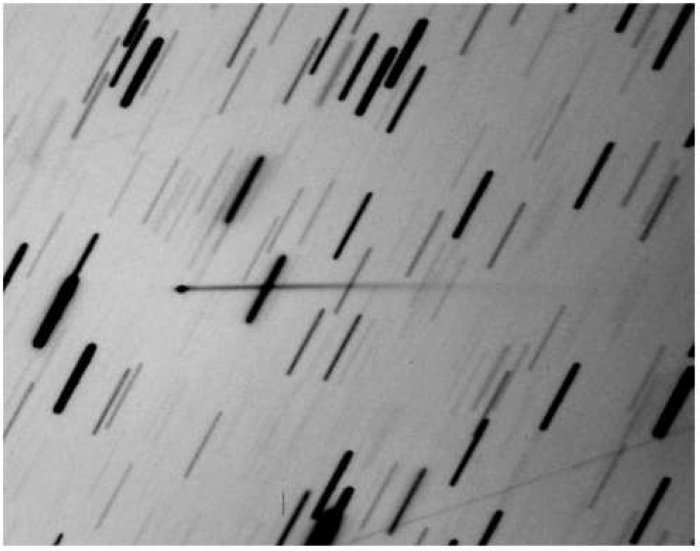
|
Figure 1 -
A 14×11 arcmin picture of (6478) Gault with its tail taken from
OAVdA on 2019 March 23, about 20:20 UT (α = 10h 04m 25.2s;
δ = −01o 08' 06".7, J2000.0).
North is up, east to the left. The main tail length is 5.5' at position angle PA ~ 272o.
Its also visible a fainter 12"-extended antitail at PA ~ 91o. The image is a stack of 38 frames,
each with 180 sec exposure time.
|

| Figure 2 -
The expected PE versus ρ relationship according to Richardson
et al. (2005). Spin-barrier critical period PE in case of a ‘cigar-shaped’
triaxial ellipsoid is obtained from the spherical case modulated by the shape
factor F of equation (2), fully depending on the body’s eccentricity. In
addition to the spherical geometry (e = 0) two cases are displayed in the plot,
respectively, with e = 0.6 and 0.4, with a slower critical period increasing
with body’s eccentricity, at fixed bulk density ρ, as labelled on the plot.
The reference bulk-density figures for C- and S-type asteroids, according to
Carbognani (2017) are reported as yellow and red bands, respectively. The
prevailing estimate of Gault’s rotation period of P = 3.34 h is marked in
the plot, together with the implied range for asteroid’s density (arrows)
ρ ~ 1 g/cm3. See text for a discussion.
|
 |
Figure 3 -
Rc-band isophotal contour plot of a Gault’s illustrative image from the Loiano data set,
along the night of 2019 April 15. Esposure time is 240 sec with telescope tracked at non-sidereal
rates to follow Gault’s motion. The displayed field of view is about 60×45 arcsec across, with North
up and East to the left. Coordinate axes are labelled in pixel scale (1 px = 0.58 arcsec).
Gault is the ‘rounded’ object about (x, y) = (362, 591) coordinates. The vertically elongated
object to the left of the image is a saturated star distorted by on-target tracking.
Seeing on the image is about 2.2 arcsec FWHM. A bright full Moon, only 12o apart was strongly
affecting the sky background, here estimated in μR ~ 16.8 mag/arcsec2. From the image, we can
however rule out at an S/N ≥ 3 confidence level any activity signature around the asteroid,
brighter than 21.9 mag/arcsec2.
|

|
Figure 4 -
Gault’s colours variations over time.
|


|
Figure 5 -
Gault’s observing sessions of 2019 March 23–27 from OAVdA (the mean uncertainty for the three sessions are,
respectively, 0.020, 0.022, and 0.023 mag) and 2019 April 15 from Loiano (mean uncertainty 0.09 mag), are
summarized in the upper and lower panels, respectively. The Rc magnitude scale is reproduced, throughout,
from the local CMC-15 calibration, according to equation (4). Along the OAVdA observations, the asteroid was
about its Earth opposition, at orbital phase angle α ~12.9o, a figure that increased to
α ~21.4o for the Loiano data. The B, V magnitude sampling from Batch #1–3 observations is marked
on the plot. Note a substantial difference
in light-curve amplitude and shape between the two observing sessions. See text for a discussion.
|

 |
Figure 6 -
Gault’s observing sessions of 2019 March 26 and 30 from
Sanchez et al. (2019) are summarized in the upper and lower panels, respectively.
|
 |
Figure 7 -
The Lomb-Scargle periodogram of spectral power versus period
(between 0.5 and 10 hours) for OAVdA’s sessions and Sanchez 30 March.
The best period is 3.34±0.02 h.
|
 |
Figure 8 -
The phased lightcurves of the March 23, 26, 27 OAVdA and
March 30 Sanchez according to the Falc algorithm implemented in MPO
Canopus. The best period is 3.36 h very near to the 3.34±0.02 h of Fig. 7.
|
 |
Figure 9 -
Like Fig. 8, according to the ~2× best period values. This phased
lightcurve is compatible with a contact binary system with equal components (Descamps 2008).
|
 |
Figure 10 -
The expected P vs. ρ relationship for a close binary system with
the asteroid consisting of two components of similar size and mass, according to eq. (7).
The component distance is parameterized in terms of multiple
"n" of the body’s reference radius, RG, as in eq. (6). Accordingly, a contact
system is obtained for n = 2, while for n = 3 the two asteroid components
are orbiting one RG apart. The nominal periodicity of case P =7 h is singled
out in the plot, with an implied density for Gault of ρ~1.0 g/cm3, in case
of a contact binary system.
|



